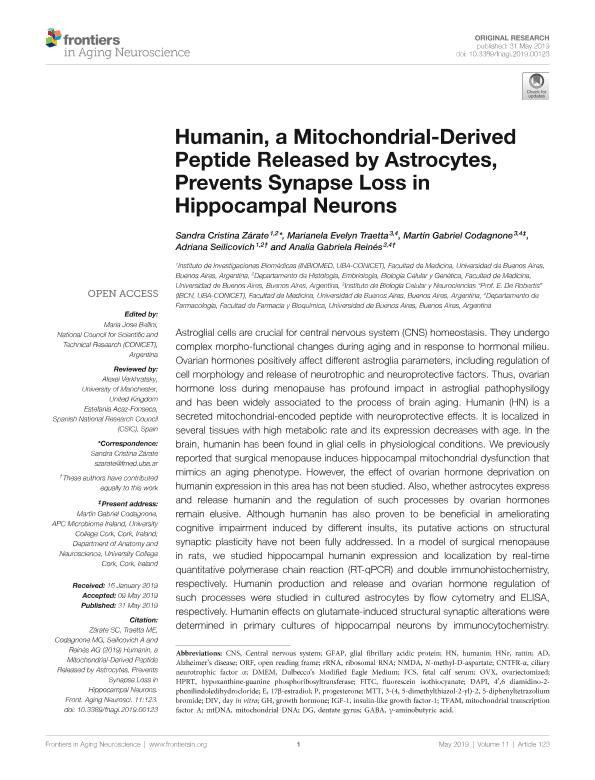Mostrar el registro sencillo del ítem
dc.contributor.author
Zarate, Sandra Cristina

dc.contributor.author
Traetta, Marianela Evelyn

dc.contributor.author
Codagnone, Martín Gabriel

dc.contributor.author
Seilicovich, Adriana

dc.contributor.author
Reines, Analia Gabriela

dc.date.available
2019-10-22T17:31:21Z
dc.date.issued
2019-05
dc.identifier.citation
Zarate, Sandra Cristina; Traetta, Marianela Evelyn; Codagnone, Martín Gabriel; Seilicovich, Adriana; Reines, Analia Gabriela; Humanin, a mitochondrial-derived peptide released by astrocytes, prevents synapse loss in hippocampal neurons; Frontiers Media SA; Frontiers in Aging Neuroscience; 11; MAY; 5-2019; 1-16
dc.identifier.issn
1663-4365
dc.identifier.uri
http://hdl.handle.net/11336/86910
dc.description.abstract
Astroglial cells are crucial for central nervous system (CNS) homeostasis. They undergo complex morpho-functional changes during aging and in response to hormonal milieu. Ovarian hormones positively affect different astroglia parameters, including regulation of cell morphology and release of neurotrophic and neuroprotective factors. Thus, ovarian hormone loss during menopause has profound impact in astroglial pathophysilogy and has been widely associated to the process of brain aging. Humanin (HN) is a secreted mitochondrial-encoded peptide with neuroprotective effects. It is localized in several tissues with high metabolic rate and its expression decreases with age. In the brain, humanin has been found in glial cells in physiological conditions. We previously reported that surgical menopause induces hippocampal mitochondrial dysfunction that mimics an aging phenotype. However, the effect of ovarian hormone deprivation on humanin expression in this area has not been studied. Also, whether astrocytes express and release humanin and the regulation of such processes by ovarian hormones remain elusive. Although humanin has also proven to be beneficial in ameliorating cognitive impairment induced by different insults, its putative actions on structural synaptic plasticity have not been fully addressed. In a model of surgical menopause in rats, we studied hippocampal humanin expression and localization by real-time quantitative polymerase chain reaction (RT-qPCR) and double immunohistochemistry, respectively. Humanin production and release and ovarian hormone regulation of such processes were studied in cultured astrocytes by flow cytometry and ELISA, respectively. Humanin effects on glutamate-induced structural synaptic alterations were determined in primary cultures of hippocampal neurons by immunocytochemistry. Humanin expression was lower in the hippocampus of ovariectomized rats and its immunoreactivity colocalized with astroglial markers. Chronic ovariectomy also promoted the presence of less complex astrocytes in this area. Ovarian hormones increased humanin intracellular content and release by cultured astrocytes. Humanin prevented glutamate-induced dendritic atrophy and reduction in puncta number and total puncta area for pre-synaptic marker synaptophysin in cultured hippocampal neurons. In conclusion, astroglial functional and morphological alterations induced by chronic ovariectomy resemble an aging phenotype and could affect astroglial support to neuronal function by altering synaptic connectivity and functionality. Reduced astroglial-derived humanin may represent an underlying mechanism for synaptic dysfunction and cognitive decline after menopause.
dc.format
application/pdf
dc.language.iso
eng
dc.publisher
Frontiers Media SA

dc.rights
info:eu-repo/semantics/openAccess
dc.rights.uri
https://creativecommons.org/licenses/by-nc-sa/2.5/ar/
dc.subject
ASTROCYTES
dc.subject
HIPPOCAMPUS
dc.subject
HUMANIN
dc.subject
MITOCHONDRIA
dc.subject
OVARIAN HORMONES
dc.subject
SYNAPSE
dc.subject.classification
Neurociencias

dc.subject.classification
Medicina Básica

dc.subject.classification
CIENCIAS MÉDICAS Y DE LA SALUD

dc.title
Humanin, a mitochondrial-derived peptide released by astrocytes, prevents synapse loss in hippocampal neurons
dc.type
info:eu-repo/semantics/article
dc.type
info:ar-repo/semantics/artículo
dc.type
info:eu-repo/semantics/publishedVersion
dc.date.updated
2019-10-15T19:39:30Z
dc.identifier.eissn
1663-4365
dc.journal.volume
11
dc.journal.number
MAY
dc.journal.pagination
1-16
dc.journal.pais
Suiza

dc.journal.ciudad
Lausanne
dc.description.fil
Fil: Zarate, Sandra Cristina. Consejo Nacional de Investigaciones Científicas y Técnicas. Oficina de Coordinación Administrativa Houssay. Instituto de Investigaciones Biomédicas. Universidad de Buenos Aires. Facultad de Medicina. Instituto de Investigaciones Biomédicas; Argentina. Universidad de Buenos Aires.Facultad de Medicina. Departamento de Histología, Embriología, Biología Celular y Genética; Argentina
dc.description.fil
Fil: Traetta, Marianela Evelyn. Consejo Nacional de Investigaciones Científicas y Técnicas. Oficina de Coordinación Administrativa Houssay. Instituto de Biología Celular y Neurociencia "Prof. Eduardo de Robertis". Universidad de Buenos Aires. Facultad de Medicina. Instituto de Biología Celular y Neurociencia; Argentina
dc.description.fil
Fil: Codagnone, Martín Gabriel. Consejo Nacional de Investigaciones Científicas y Técnicas. Oficina de Coordinación Administrativa Houssay. Instituto de Biología Celular y Neurociencia "Prof. Eduardo de Robertis". Universidad de Buenos Aires. Facultad de Medicina. Instituto de Biología Celular y Neurociencia; Argentina
dc.description.fil
Fil: Seilicovich, Adriana. Consejo Nacional de Investigaciones Científicas y Técnicas. Oficina de Coordinación Administrativa Houssay. Instituto de Investigaciones Biomédicas. Universidad de Buenos Aires. Facultad de Medicina. Instituto de Investigaciones Biomédicas; Argentina. Universidad de Buenos Aires.Facultad de Medicina. Departamento de Histología, Embriología, Biología Celular y Genética; Argentina
dc.description.fil
Fil: Reines, Analia Gabriela. Consejo Nacional de Investigaciones Científicas y Técnicas. Oficina de Coordinación Administrativa Houssay. Instituto de Biología Celular y Neurociencia "Prof. Eduardo de Robertis". Universidad de Buenos Aires. Facultad de Medicina. Instituto de Biología Celular y Neurociencia; Argentina
dc.journal.title
Frontiers in Aging Neuroscience
dc.relation.alternativeid
info:eu-repo/semantics/altIdentifier/url/https://www.frontiersin.org/article/10.3389/fnagi.2019.00123/full
dc.relation.alternativeid
info:eu-repo/semantics/altIdentifier/doi/http://dx.doi.org/10.3389/fnagi.2019.00123
Archivos asociados
